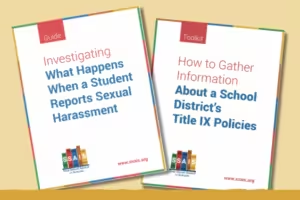 SSAIS toolkits help keep students safe on and off campus. Explore them on our toolkits webpage.
SSAIS toolkits help keep students safe on and off campus. Explore them on our toolkits webpage.
It’s up to all of us to take action to make our schools safe places to learn free from gender-based discrimination. See below for a list of ideas.
The SSAIS Action Guide lists dozens of ideas for student activism:
Activities for students and their allies
- Share the full video Sexual Harassment: Not in My School! or excerpts with friends, your school, parent teacher organization, and community organizations.
- Share the toolkit Ending K-12 Sexual Harassment with the entire school community.
- Form a gender equality group or a SASH Club (Students Against Sexual Harassment). Partner with SSAIS: contact info@stopsexualassaltinschools.org.
- Forge intersectional alliances. Partner with existing school clubs, such as a Suicide Prevention club or Gay Straight Alliance (GSA).
- Make posters about sexual harassment and students’ rights. Ask questions like “Does gender equality exist in our school?” and invite students to the meetings.
- Create a brochure or notebook insert with information about students’ rights and resources to address sexual harassment and assault.
- Create a Students’ Bill of Rights and post at school.
- Ask your school to make announcements about respectful behavior, how to make reports of sexual harassment, the school’s policies and disciplinary actions, and how to improve the school culture.
- Start a campaign to end sexual harassment at school.
- Create a pledge against sexual harassment and assault.
- Write about sexual harassment, gender equality, and Title IX for the school newspaper
- Make zines about gender equality, students’ rights, and more.
- Create PSAs about sexual harassment, students’ rights, confidentiality, etc.; ask permission before posting.
- Create a Facebook Page and blogs for your activism.
- Invite speakers to explain sex discrimination, sexual harassment, and Title IX.
- Discuss healthy relationships and consent; use online resources at SSAIS.org/video and/or invite speakers to make presentations.
- Learn how to stand up to sexual harassment when you see it happening.
- Support those who experience sexual harassment and assault.
- Work with your school’s parent teacher organization: teach them about students’ rights and ask them to support gender equality projects.
- Create surveys about sexual harassment, gender equality, sexual harassment, etc. at your school and share the results with the school administration, community. organizations, and even the media; research these topics for school projects.
- Use your special talents, e.g. photography, writing, art, music, drama, athletics, dance, etc. to raise awareness about gender equality and sexual harassment.
- Partner with community organizations to raise awareness about sex discrimination and harassment. Work with your local sexual assault response organizations and use resources on the SSAIS Sexual Assault Responders webpage.
Activities to overcome gender stereotypes
- Discuss gender stereotypes after watching 20+ films and talks listed at SSAIS.org/video.
- Start a healthy masculinity club open to all students.
- Watch online videos by men who promote healthy masculinity (See SSAIS.org/video for a list of videos and films).
- Invite speakers on healthy masculinity and gender identification.
- Post supportive articles on social media.
- Make PSAs and posters.
- Partner with gender equality groups and model respectful behavior.
- Learn about bystander intervention and intervene when you hear others saying or posting inappropriate sexual comments.
- Speak up for others and treat your partner with respect.
For parents and adults: learn and talk with students!
- Explore Parents: You Can Become the Agent of Change for Title IX Policies, How to Gather Information about a School District’s Title IX Policy, and How to Address Sexual Harassment and Assault with Children.
- Watch the video clip What adults can do about K-12 sexual harassment and assault.
- Learn about school sexual harassment, sexual assault, cyber harassment, and dating violence on the Sexual Harassment Defined webpage.
- Explore the SASH Club Power Topics covering a wide range of potential harms.
- Learn about the signs of sexual abuse, assault, and trauma on the Safety and Prevention pages at the RAINN.org website.
- Learn about school sexual harassment, sexual assault, cyber harassment, and dating violence.
- Talk about how sexual harassment is prohibited at school, just like it is in the workplace.
- Help students recognize sexual exploitation, grooming, and abuse by teachers or staff. Explore the presentation Sexual Misconduct by School Employees.
- Encourage students to stand up to harassment and discrimination, whether against themselves or others; reach out to students who are uncomfortable talking with their families.
- Explore the SSAIS website resources to learn about your school’s responsibilities to protect students.
- Encourage students and parents to start advocacy groups and contact SSAIS for help.
Learn about school policies and Title IX responsibilities
- Interview school staff and the Title IX Coordinator by using the Title IX Checklist in the new guide How to Gather Information About A School District’s Title IX Policies.
- Read your school’s anti-discrimination and anti-harassment policies.
- Ask what actions the school takes when it learns of sexual harassment or discrimination.
- Find out what the school is doing proactively about sexual harassment.
- Find out what complaint pathways exist if the school determines Title IX does not apply.
- Make sure your school has a Title IX coordinator and their contact information is publicly available.
- Visit the Stop Sexual Assault in School website for many helpful resources.
Is a school Title IX compliant?
- Interview school staff and the Title IX Coordinator the guide How to Gather Information About A School District’s Tile IX Policies.
- Contact the Title IX coordinator to make a presentation to your school, parent teacher organization, or community organization.
- Refer school staff to the SSAIS Title IX Coordinators webpage.
- When you speak to the Title IX coordinator, ASK: what does the district do to promote gender equality in the classroom and in school activities? Does the school educate students about gender stereotypes and sex discrimination? Does the school educate staff on how to compassionately treat students who report sexual harassment? Does the school educate staff on how to handle sexual assault complaints and how to address retaliation if it occurs
- Visit Problem with Your School on the SSAIS.org website for next steps.
Update staff response to sexual harassment
- Share the SSAIS Fact Sheet for Teachers and Staff.
- Invite community experts from your local sexual assault crisis center or coalition to train school staff, administrators, and counselors about a trauma-informed response to students who report sexual harassment and assault.
Projects for school counselors and administrators
SSAIS wants educators and counselors to create a culture of service that engages students, helps them take action, and makes an impact in their community.
- Educate your school district about Title IX.
- Teach students about Title IX’s right to an equal education.
- Teach students about the negative impact of sexual harassment.
- Teach students about sexual cyber bullying.
- Start a Students Against Sexual Harassment (SASH) Club to end sexual harassment at your school.
- Learn how to appropriately support survivors of sexual harassment and assault.
- Teach male students to stop sexual harassment and assault.
- Address sexual violence committed by male athletes and engage their support
- Promote bystander intervention for all genders.
- Create projects for LGBTQ+ youth; engage your GSA.

- Create projects for elementary aged school children.
- Connect with college organizations to partner with your middle and/or high school in the creation of education equity projects and clubs.
- Support the projects described under “Tools for students.”
- Request classroom teachers to accept individual projects about the impact of sexual harassment/assault on education equality.
Projects for community and student-run organizations
- Educate students and families about Title IX and the right to an equal education.
- Inform students about the negative impact of sexual harassment on their well-being and education.
- Create projects for students to work in the community spreading awareness about their rights, sexual harassment/assault prevention, etc. Support student projects above.
- Facilitate college-aged students and young adults mentoring pre-college students about sexual assault prevention and advocating for their rights under Title IX.
- Encourage youth to volunteer for organizations like ours to gain valuable experience for their college and employment resumes.
- Start a Students Against Sexual Harassment (SASH) Club to end sexual harassment at your school.
Projects for retired educators or adults who wish to volunteer from home
- Help track school districts’ Title IX compliance around the country by sending out our guide How to Gather Information about a School District’s Title IX Policies.
- Connect college sexual assault awareness groups with high schools to build relationships.
- Chose any area that uses your talents and extend those talents to our organization. See Get Involved for a just few ideas.
- Help recruit other volunteers in numerous fields (to help SSAIS).
Projects for graduate students
Contact us for internship and externship opportunities.
- Help us follow non-compliant school districts around the country to create awareness in those communities. Use our protocols or invent your own. Share your results on our website.
- Help design Title IX brochures for K-12 students in your community.
- Create mock Title IX cases and bring them to high schools in your outreach programs.
- Contact us to join our social media team.
